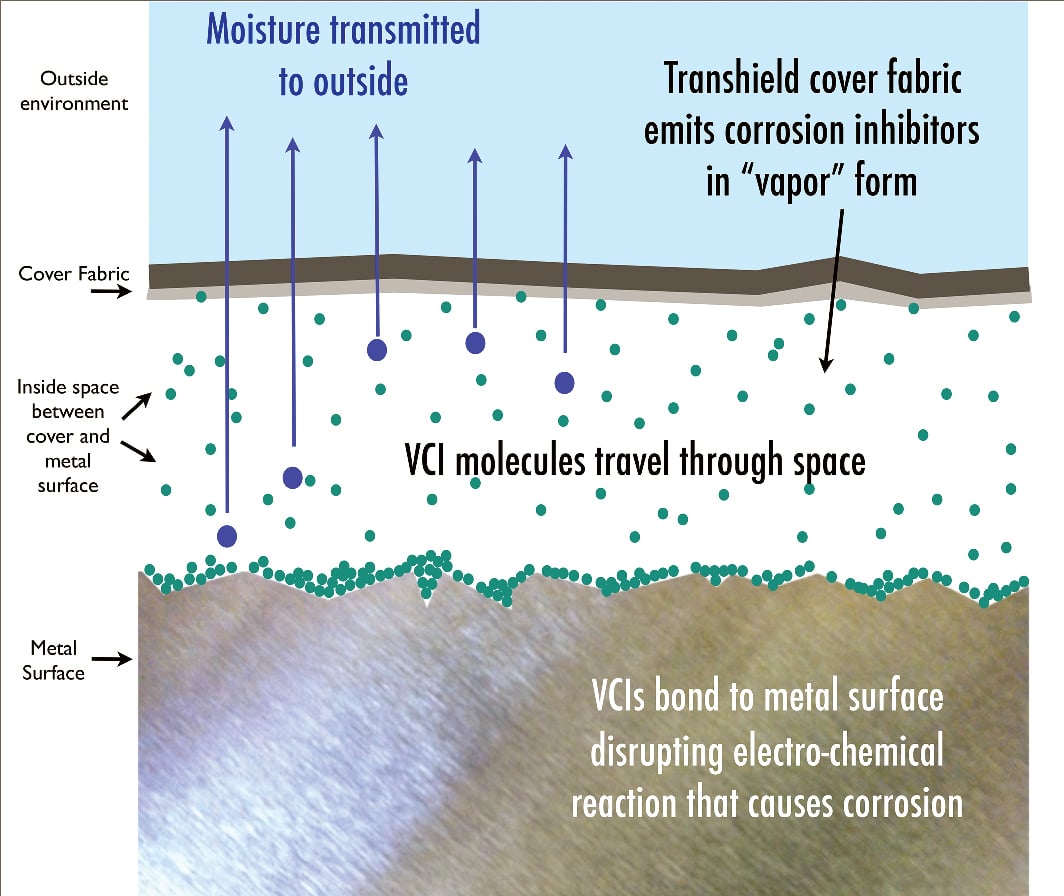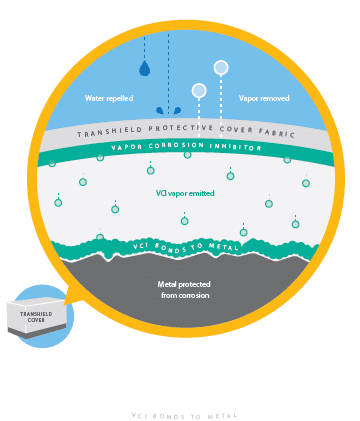Machinery and other corrosion-prone equipment are some of the most valuable commodities transported in the United States. In 2018, according to the U.S. Department of Transportation’s Freight Facts and Figures, the machinery and miscellaneous manufactured products combined had a value of $1.8 trillion. Machinery, electronics, and motorized vehicles were the top three categories, in that order.
When you pair that with the fact that ferrous metals, like steel and iron are vulnerable to corrosion as soon as they’ve been manufactured, it’s easy to see the potential for high monetary losses due to corrosion. Corrosion costs the global economy trillions of dollars every year through maintenance costs and depreciation. The problem is further exacerbated when transport is over water. The salt and moisture inherent in overseas transport increases corrosion build up at an exponential rate.
Vapor corrosion inhibitors (VCI’s) were created as a cutting-edge method to eliminate the possibility of rust and corrosion. Since their introduction in the middle of the 20th century, these corrosion-preventing compounds have been an extreme help in preventing both short-term and long-term corrosion on valuable assets and extending the useful life of these assets.
One question that is asked often is, are VCIs safe for humans?
Before answering this question, it’s important understand what makes VCIs work, the different kinds of vapor corrosion inhibitor compounds and where they’re used, and what defines “dangerous” or “toxic” for humans.
What Is a VCI?
VCI is an acronym for “vapor corrosion inhibitor” or “volatile corrosion inhibitor”. A VCI can take the form of a chemical substance or a combination of chemical substances that significantly reduce and prevent corrosion on metals. VCIs are introduced to the asset by means of a carrier that works as a source. This can be a liquid, coated paper, compounded film, a tablet, a powder, or an adhesive. In many cases, it can be implemented in the main packaging solution such as a box or a cover.
Some frequently used VCI compounds in the industry are sodium nitrite, benzotriazole, dicyclohexylammonium nitrite, dicyclohexylammonium benzoate, and cyclohexylamine benzoate2.
VCI compounds work by vaporizing from the source and forming a thin molecular layer over the surface of the metal in an enclosed space. That molecular layer shields the metal’s surface from reacting with environmental elements that typically cause corrosion – such as oxygen. Once a protective film is created on the metal surface, the VCIs keep releasing from the source until there is an equilibrium in the packaging space. This allows constant availability of VCI chemistry within the package. VCI’s are used in situations where it’s not practical to use surface treatments such as rust-preventative oils, or with equipment that has vulnerable, hard to reach areas.

Example of VCI Packaging Material
For a VCI to be effective, optimal vapor pressure is essential — too low, and it will take too long for the corrosion inhibitor to reach an effective protection level. Too high, and the VCI gets consumed too quickly which then limits the duration of effective concentration and protection.
It is preferred to have a blend of chemistries that combine speed and long-lasting benefits to the package. It requires a vast amount of chemistry knowledge, engineering, and science to create an optimal VCI package that works in a wide variety of climates and situations. Even if the basic individual chemistries are known, due to this high level of sophistication, most VCI manufacturers keep their formulation a trade secret – just like Coca-Cola® does with its cola formula.
When Were VCIs First Used?
The history of corrosion inhibitors goes all the way back to the 20th century where ammonia was used to protect the exposed and immersed parts of steam boiler circuits1. Less dangerous, more effective compounds began to be used commercially in the early 1940’s as chemistry advanced. VCIs were also used and tested by the U.S. Navy during World War II when tactical assets on warships began to rust and need replacement.
Today there are hundreds of known VCI compounds, however, only a fraction of them are considered acceptable to use in regulated commercial markets. Some of this is due to manufacturing costs and the difficulty in controlling manufacturing temperatures and pressures to provide a controllable chemistry.
Where Is VCI Used?
Corrosion inhibitors are used in variety of applications, from water pipelines to engine oils, to parts packaging. The primary application for a VCI is to protect metals, machinery, and equipment during transportation and storage. VCIs can be infused into protective materials such as paper, polymer coatings (paint), shrink wrap, liquids, and adhesives. The more active VCI components can be in powder or liquid form.
Toxicity of VCI
This field of science, also referred to as toxicology, tries to understand the adverse effects that chemicals can have on people, wildlife, and the environment in general1.
Many factors determine whether a person will have a negative reaction to a chemical compound, some of which are:
- A person’s age and current health state
- The dosage of the chemical they are exposed to
- The duration of time that someone is exposed to the chemical
- Routes of exposure – oral, inhalation, dermal
These factors are important to know before understanding if VCI is indeed toxic to you. What’s the concentration level or dosage of VCI you’ll be exposed to? How long will you be exposed and what is your proximity to the VCI? Do you have any underlying health conditions that might be prone to triggering a more negative reaction to VCI compounds?
One method to understand the level of toxicity of chemicals is the LD50 model. This is the median lethal dose — a dose that will kill 50% of an exposed test population — usually expressed in mg/kg. The higher the number, the lower the toxicity. This data on common products can be obtained from Safety Data Sheets (SDS). For example:
| Compound | Dosage |
| Table salt | LD50 = 3,000 mg/Kg in rats (oral) |
| Nicotine | LD50 = 50 mg/Kg in rats (oral) |
| Coffee | LD50 = 127 mg/Kg in rats (oral) |
| Transhield VCI* | LD50 = 1,050 mg/Kg in rats (oral) |
Just to keep things in perspective, even water has a toxicity level that may be fatal at elevated levels of consumption. And as the list above indicates, VCI’s can have a lower toxicity level than nicotine and coffee!
Other types of toxicology focuses on environmental hazards such as water (detergents, fertilizer, pesticides, and heavy metals), soil (herbicides, pesticides, PCBs), and air (particulate matter, carbon monoxide, lead, and nitrogen dioxide).
As you’ll learn in the following sections, the majority of VCI infused products sold commercially do not contain enough VCI to cause serious harm to humans. However, this doesn’t mean VCI compounds shouldn’t be taken seriously and handled with caution when advised. As you’ll read, certain VCI compounds are safer than others.
Are VCIs Dangerous?
How VCIs are applied will determine their level of toxicity to humans. High doses, or 100% pure samples of VCI compounds in raw form, when inhaled, ingested, or contacted by humans, can be toxic if over exposure takes place for a prolonged period. However, in packaging applications, the products are built-in as coatings or compounds. Therefore, the level of concentration is much lower.
If you choose the right product, sourced through a reputable supplier — and handle the VCI according to supplier’s recommendations — they are normally safe. If handling a more concentrated dosage of VCI in soluble or liquid form, it’s recommended you use the personal protection equipment recommended by the manufacturer – masks, gloves, eyewear, etc.
Referencing back to our toxicology section, it’s important to know your health conditions prior to exposing yourself to VCI. Someone with a respiratory or skin condition, for example, may be at higher risk when around high doses of VCI.
Are VCIs in Protective Packaging Safe for Human Handling, and Inhalation?
When applied in protective packaging products – paper, shrink wrap, paint coatings, desiccants, etc. – VCI compound concentrations typically do not contain a high enough dosage to cause serious harm. And, if you limit the time you spend around the VCI compounds, and your proximity to the substance, you will be at less of a risk of seeing negative health effects.
Additionally, after the removal of VCI infused protective packaging (films, paper, coatings, emitters, etc.) the VCI molecules within the packaging space dissipate. There is no major inhalation or contact risks.
Why is VCI Important?
Without VCI protection, equipment and other metal products would be more susceptible to corrosion. Corrosion is both dangerous (as it compromises the integrity of the product) and costly. Here are some of the high-level benefits of using VCI for corrosion protection:
- Significant cost-savings for manufacturers
- Less warranty claims from customers
- Less part replacements
- Less labor time spent applying tedious protection methods
- Oil / Grease lubricants
- Delayed depreciation of assets, both cosmetically and functionally
- Safer products through sustaining structural integrity
How does Transhield use VCIs?
Transhield is a pioneer in the use of VCI technology to protect valuable assets during transport and storage. Since the 1990s we have been integrating our VCI chemistry into our patented 3-layer fabric technology. Now, nearly all Transhield protective materials can have a VCI additive implemented for corrosion prevention and reduction.

Transhield utilizes a patented method that compounds corrosion inhibitors into a preparatory hot melt adhesive formula. The adhesive is used for the lamination process of our fabrics. Since the VCIs are encapsulated within the adhesive, and the adhesive is hidden between the outer film layer and the soft nonwoven layer of our fabrics, there is no physical contact with the VCI chemistry when the covers are handled for installation and removal.
Furthermore, the porosity difference between the outer polyethylene film and the inner nonwoven creates a situation in which vaporized corrosion inhibitors can only move toward the packaged asset. The heat shrinking process heats the adhesive with VCI and accelerates the evaporation rate of the inhibitors. This helps increase the rate of protection as soon as the cover is applied and creates a VCI laden atmosphere within the package.
In addition to the above benefits, Transhield utilizes multiple VCI chemistries that have different vapor pressures. This allows our products to provide both short-term and long-term protection.
To optimize the benefits of VCIs it’s important that the cover fits correctly. A cover designed to protect on all 6-sides, with minimal or no opening, provides the best environment to achieve the full benefit of VCIs. A fully enclosed cover system locks the vapor corrosion inhibitors within the package for the duration of the packaging application. A package with multiple openings creates pathways for the VCIs to escape and therefore diminish the efficiency of the inhibitors and the cover.
Safety Education Sources for VCI Compounds
If you want to check the safety data and exposure-related information of a specific VCI compound you use, or if you want more information on various VCI compounds, check out these helpful sources:
- Cameo Chemicals – Database of hazardous chemical datasheets that allows you to search chemicals by name, ID number, etc. Each chemical will have its own profile – showing exposure data, hazard warnings, the recommended personal protection equipment to wear when handling, and more.
- ChemView – A searchable public database created by the EPA. This expanding database allows you to search any chemical compound and its safety data, manufacturing/use data, and more.
Sources
1“Toxicology.” National Institute of Environmental Health Sciences, U.S. Department of Health and Human Services, www.niehs.nih.gov/health/topics/science/toxicology/index.cfm.
2Gangopadhyay, S., & Mahanwar, P. (2018). Recent developments in the volatile corrosion inhibitor (VCI) coatings for metal: a review. Journal of Coatings Technology and Research, 15(4), 789-807.
3Yaro, S.A., Khadom, A.A., & Ibraheem, F.H. (2011). Peach juice as an anti‐corrosion inhibitor of mild steel. Anti-Corrosion Methods and Materials, 58(3), 116-124.